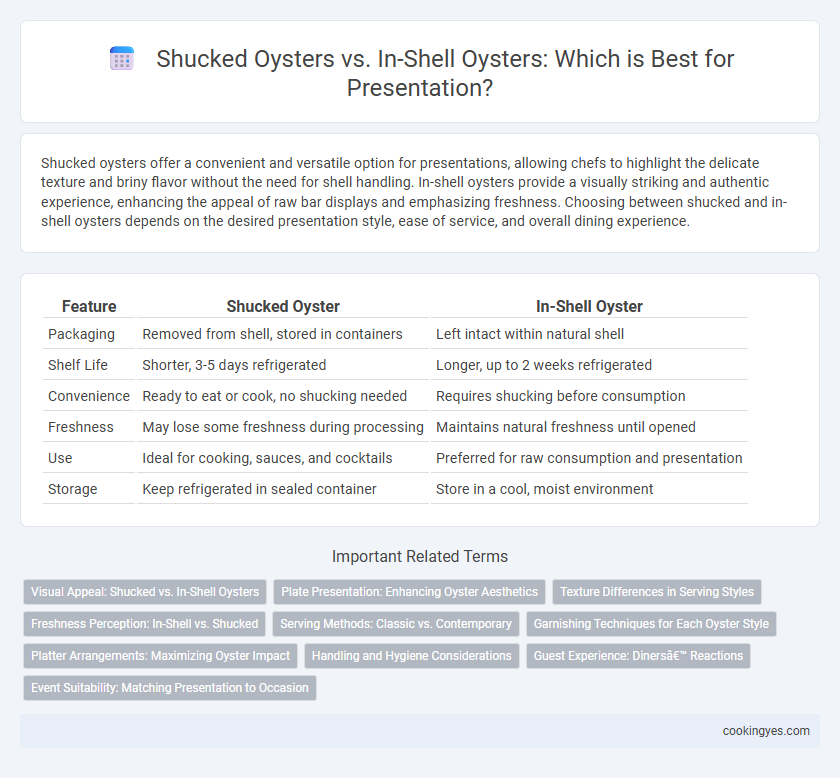Shucked oysters offer a convenient and versatile option for presentations, allowing chefs to highlight the delicate texture and briny flavor without the need for shell handling. In-shell oysters provide a visually striking and authentic experience, enhancing the appeal of raw bar displays and emphasizing freshness. Choosing between shucked and in-shell oysters depends on the desired presentation style, ease of service, and overall dining experience.
Table of Comparison
| Feature | Shucked Oyster | In-Shell Oyster |
|---|---|---|
| Packaging | Removed from shell, stored in containers | Left intact within natural shell |
| Shelf Life | Shorter, 3-5 days refrigerated | Longer, up to 2 weeks refrigerated |
| Convenience | Ready to eat or cook, no shucking needed | Requires shucking before consumption |
| Freshness | May lose some freshness during processing | Maintains natural freshness until opened |
| Use | Ideal for cooking, sauces, and cocktails | Preferred for raw consumption and presentation |
| Storage | Keep refrigerated in sealed container | Store in a cool, moist environment |
Visual Appeal: Shucked vs. In-Shell Oysters
Shucked oysters, presented on a bed of crushed ice or in elegant dishes, emphasize the delicate texture and plumpness of the meat, creating a refined and accessible visual appeal for diners. In-shell oysters maintain their rugged, natural appearance, showcasing the intricate ridges and unique shapes of each shell, which adds an authentic and rustic charm to seafood platters. The choice between shucked and in-shell oysters affects the overall presentation by balancing the contrast between raw, untouched elegance and the ready-to-eat sophistication of oyster meat.
Plate Presentation: Enhancing Oyster Aesthetics
Shucked oysters offer a sleek and refined plate presentation, showcasing the delicate meat nestled in its natural juice, often arranged on a bed of crushed ice or seaweed to enhance freshness perception. In-shell oysters present a rustic and authentic aesthetic, leveraging the natural curvature and texture of the shell to create visual interest and emphasize the oceanic origin, often paired with lemon wedges or mignonette sauce for contrast. Both styles enhance oyster aesthetics through distinct visual and textural cues, elevating the dining experience in upscale or casual settings.
Texture Differences in Serving Styles
Shucked oysters offer a smooth, creamy texture that enhances the briny flavor, making them ideal for raw consumption or delicate sauces. In-shell oysters maintain their natural firmness and provide a slight chewiness, which contributes to a more robust and tactile eating experience. Presentation of shucked oysters often emphasizes their silky consistency, while in-shell servings highlight the oyster's freshness and visual appeal by preserving the shell's protective environment.
Freshness Perception: In-Shell vs. Shucked
In-shell oysters convey a stronger freshness perception due to their natural protection and minimal handling, preserving the oyster's original environment until consumption. Shucked oysters, while convenient, may appear less fresh because the exposure to air and transfer into containers can slightly diminish the sensory cues of freshness. Consumers often associate the intact shell with guaranteed freshness and quality, influencing their purchase and presentation preferences.
Serving Methods: Classic vs. Contemporary
Shucked oysters, typically served on a half shell, offer a contemporary presentation that highlights ease of consumption and versatility in garnishes like mignonette or cocktail sauce. In-shell oysters maintain a classic aesthetic, often presented on crushed ice to preserve freshness and emphasize their natural origin. Both serving methods cater to distinct dining experiences, with shucked oysters favoring modern plating and in-shell oysters preserving tradition.
Garnishing Techniques for Each Oyster Style
Shucked oysters offer a smooth surface ideal for precise garnishing techniques such as delicate herb sprigs, citrus zest curls, and small dollops of flavored sauces, enhancing visual appeal and flavor complexity. In-shell oysters provide a natural, rugged presentation platform where larger garnishes like lemon wedges, seaweed, and edible flowers complement the oyster's rustic look while adding vibrant color and texture contrast. Both styles benefit from careful placement of garnishes to highlight freshness and create an inviting presentation tailored to the dining experience.
Platter Arrangements: Maximizing Oyster Impact
Shucked oysters offer a sleek and clean appearance, allowing for creative platter arrangements that highlight their briny texture and fresh flavor. In-shell oysters provide a rustic, natural presentation that enhances the visual appeal with their varied shell shapes and colors, perfect for elegant or casual displays. Combining both types on a platter maximizes impact by offering textural contrast and visual variety, elevating the overall dining experience.
Handling and Hygiene Considerations
Shucked oysters require meticulous handling to prevent contamination, as their exposed flesh is more susceptible to bacterial growth compared to in-shell oysters, which retain a natural protective barrier. Proper refrigeration between 32degF and 41degF and use of sanitized tools are critical to maintaining hygiene standards when serving shucked oysters. In-shell oysters benefit from their intact shells that limit exposure, but still demand careful storage and cleaning to ensure food safety during presentation.
Guest Experience: Diners’ Reactions
Shucked oysters provide diners with convenience and immediate access to the creamy, briny meat, enhancing the sensory experience without the effort of opening shells. In-shell oysters offer a visually striking presentation, heightening anticipation and engagement as guests shuck them at the table, creating an interactive and memorable dining moment. Both formats influence guest satisfaction differently, with shucked oysters appealing to ease and flavor, while in-shell oysters emphasize ritual and freshness.
Event Suitability: Matching Presentation to Occasion
Shucked oysters offer ease of consumption, making them ideal for casual events, cocktail parties, or large gatherings where quick serving and minimal utensils are preferred. In-shell oysters present a visually striking and elegant option, perfect for upscale dinners, formal receptions, or culinary showcases where presentation enhances the dining experience. Selecting between shucked and in-shell oysters ensures the presentation aligns with the event's atmosphere and guest expectations.
Shucked oyster vs In-shell oyster for presentation Infographic

 cookingyes.com
cookingyes.com